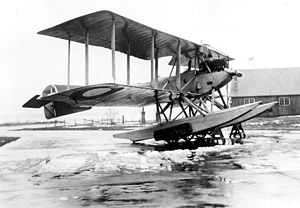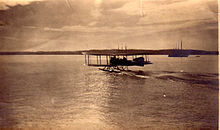Friedrichshafen FF.49
Appearance
| FF.49 | |
|---|---|
 | |
| General information | |
| Type | Reconnaissance |
| Manufacturer | Flugzeugbau Friedrichshafen GmbH |
| Primary users | Kaiserliche Marine |
| Number built | 240 |
| History | |
| Introduction date | September 1917 |
| First flight | 1917 |
| Developed from | Friedrichshafen FF.33 |
Friedrichshafen FF.49 was a German, two-seat, single-engine float-plane designed by Flugzeugbau Friedrichshafen in 1917.
Variants
[edit]- FF.39
- Two-seat reconnaissance float-plane, powered by a 150 kW (200 hp) Benz Bz.IV water-cooled 6-cylinder piston engine. 14 built.
- FF.49b
- Two-seat bomber float-plane. 25 built.
- FF.49c
- Two-seat reconnaissance float-plane.
- LFG V 1
- Redesigned civil derivative of FF.49c by Luft-Fahrzeug-Gesellschaft (LFG) with wider fuselage, modified wing profile and seats for three passengers in raised cabin. Two converted 1919.[1]
- LFG V 2
- Redesigned civil derivative of FF.49c by LFG with wider fuselage, modified wing profile and seats for five passengers in two cabins. Two converted 1919.[1]
- Orlogsværftet HB.II
- Seven FF.49s re-conditioned at the Orlogsværftet / Flyvetroppernes Værksteder in Denmark.
Operators
[edit] Denmark
Denmark- Royal Danish Navy
- Danish Air Lines started operations with a FF.49 equipped to carry two passengers on the Copenhagen–Warnemünde on 7 August 1920.[2]
 Finland
Finland- Finnish Air Force (four FF.49C, one FF.49B; in use 1918–1923)
 German Empire
German Empire- Kaiserliche Marine
 Germany
Germany- Deutsche Luft-Reederei[3]
- Luftdeinst[4]
- Luft-Fahrzeug-Gesellschaft operated LFG V1 and V2s on passenger services between Stralsund and Rügen and joyriding at Baltic beach resorts 1919–1920.[1]
- Lloyd Luftverkehr Sablatnig[4]
 Netherlands
Netherlands- Royal Netherlands Navy
 Norway
Norway- (four FF.49C, by A/S Aero)
 Poland
Poland- Polish Air Force (postwar)
 Sweden
Sweden- Swedish Navy (postwar), (two FF.49C, in use 1919–1924)
Specifications (FF.49c)
[edit]
Data from Flugzeugbau Friedrichshafen GmbH,[5] Thulinista Hornetiin – 75 vuotta Suomen ilmavoimien lentokoneita[6]
General characteristics
- Crew: 2
- Length: 11.65 m (38 ft 3 in)
- Upper wingspan: 17.15 m (56 ft 3 in)
- Lower wingspan: 16.7 m (54 ft 9 in)
- Height: 4.45 m (14 ft 7 in)
- Wing area: 71.16 m2 (766.0 sq ft)
- Empty weight: 1,515 kg (3,340 lb)
- Gross weight: 2,147 kg (4,733 lb)
- Fuel capacity: 294 kg (648 lb)
- Powerplant: 1 × Benz Bz.IV 6-cylinder water-cooled in-line piston engine, 150 kW (200 hp)
- Propellers: 2-bladed fixed-pitch propeller
Performance
- Maximum speed: 140 km/h (87 mph, 76 kn)
- Cruise speed: 130 km/h (81 mph, 70 kn)
- Range: 700 km (430 mi, 380 nmi)
- Endurance: 5 hours 40 minutes
- Time to altitude:
- 800 m (2,600 ft) in 6 minutes 12 seconds
- 1,000 m (3,300 ft) in 8 minutes
- 1,500 m (4,900 ft) in 13 minutes 12 seconds
- 800 m (2,600 ft) in 6 minutes 12 seconds
Armament
- Guns: 1 × fixed forward-firing 7.92 mm (0.312 in) LMG 08/15 machine gun ; 1x flexible 7.92 mm (0.312 in) Parabellum MG14
- Bombs: 4 × 12.7 kg (28 lb) bombs
See also
[edit]Related lists
- List of military aircraft of Finland
- List of military aircraft of Germany
- List of flying boats and floatplanes
References
[edit]- ^ a b c Stroud Aeroplane Monthly April 1990, pp. 241–242
- ^ Stroud 1966, p. 279
- ^ Stroud 1966, p. 280
- ^ a b Stroud 1966, pp. 279–280
- ^ Kober, Theodor von; Borzutzki, Siegfried. Flugzeugbau Friedrichshafen GmbH (in German) (1. Aufl ed.). Burbach. pp. 146–148. ISBN 978-3927513600.
- ^ Timo Heinonen (1992). Thulinista Hornetiin – 75 vuotta Suomen ilmavoimien lentokoneita (in Finnish). Tikkakoski: Keski-Suomen ilmailumuseo. ISBN 951-95688-2-4.
Bibliography
[edit]Wikimedia Commons has media related to Friedrichshafen FF.49.
- Borzutzki, Siegfried (1993). Flugzeugbau Friedrichshafen GmbH: Diplom-Ingenieur Theodor Kober [Friedrichshafen Aircraft Company: Diploma-Engineer Theodore Kober] (in German). Berlin: Burbach. ISBN 3-927513-60-1.
- Herris, Jack (2016). Friedrichshafen Aircraft of WWI: A Centennial Perspective on Great War Airplanes. Great War Aviation Centennial Series. Vol. 21. Charleston, South Carolina: Aeronaut Books. ISBN 978-1-935881-35-3.
- Klaauw, Bart van der (March–April 1999). "Unexpected Windfalls: Accidentally or Deliberately, More than 100 Aircraft 'arrived' in Dutch Territory During the Great War". Air Enthusiast. No. 80. pp. 54–59. ISSN 0143-5450.
- Nelcarz, Bartolomiej & Peczkowski, Robert (2001). White Eagles: The Aircraft, Men and Operations of the Polish Air Force 1918–1939. Ottringham, UK: Hikoki Publications. ISBN 1-902109-73-2.
- Stroud, John (1966). European Transport Aircraft since 1920. London: Putnam.
- Stroud, John (April 1990). "Wings of Peace". Aeroplane Monthly. Vol. 18, no. 4. pp. 241–247. ISSN 0143-7240.
